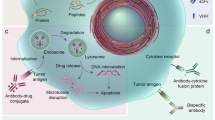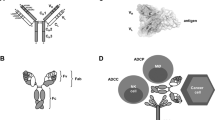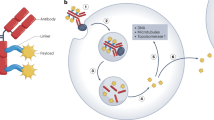Abstract
Rationally designed anticancer agents that target cell-surface antigens or receptors represent a promising approach for treating cancer patients. However, antibodies that bind these targets are often, by themselves, non-cytotoxic. By attaching potent toxins we can dramatically improve the clinical utility of some anti-tumour antibodies. Here we describe the construction and clinical utility of several recombinant immunotoxins; each of which is composed of antibody Fv fragments fused to powerful bacterial toxins. Results from clinical trials indicate that recombinant immunotoxins and similar agents that are designed to combine antibody selectivity with toxin cell-killing potency will be useful additions to cancer therapy.
This is a preview of subscription content, access via your institution
Access options
Subscribe to this journal
Receive 12 print issues and online access
$209.00 per year
only $17.42 per issue
Buy this article
- Purchase on Springer Link
- Instant access to full article PDF
Prices may be subject to local taxes which are calculated during checkout




Similar content being viewed by others
References
FitzGerald, D. J., Kreitman, R., Wilson, W., Squires, D. & Pastan, I. Recombinant immunotoxins for treating cancer. Int. J. Med. Microbiol. 293, 577–582 (2004).
Frankel, A. E., Neville, D. M., Bugge, T. A., Kreitman, R. J. & Leppla, S. H. Immunotoxin therapy of hematologic malignancies. Semin. Oncol. 30, 545–557 (2003).
Foss, F. M., Saleh, M. N., Krueger, J. G., Nichols, J. C. & Murphy, J. R. in Clinical Applications of Immunotoxins (ed. Frankel, A. E.) 63–81 (Springer, Berlin, Germany, 1998).
Uckun, F. M. & Reaman, G. H. Immunotoxins for treatment of leukemia and lymphoma. Leuk. Lymphoma 18, 195–201 (1995).
Engert, A., Sausville, E. A. & Vitetta, E. in Clinical Applications of Immunotoxins (ed. Frankel, A. E.) 13–33 (Springer, Berlin, Germany, 1998).
Naglich, J. G., Metherall, J. E., Russell, D. W. & Eidels, L. Expression cloning of a diptheria toxin receptor: identity with a heparin-binding EGF-like growth factor precursor. Cell 69, 1051–1061 (1992).
Zhao, G. & London, E. Behavior of diphtheria toxin T domain containing substitutions that block normal membrane insertion at Pro345 and Leu307: control of deep membrane insertion and coupling between deep insertion of hydrophobic subdomains. Biochemistry 44, 4488–4498 (2005).
Smallshaw, J. E. et al. Genetic engineering of an immunotoxin to eliminate pulmonary vascular leak in mice. Nature Biotechnol. 21, 387–391 (2003).
Gould, B. J. et al. Phase I study of an anti-breast cancer immunotoxin by continuous infusion: Report of a targeted toxic effect not predicted by animal studies. J. Natl Cancer Inst. 81, 775–781 (1989).
Pai, L. H. et al. Clinical evaluation of intraperitoneal Pseudomonas exotoxin immunoconjugate OVB3-PE in patients with ovarian cancer. J. Clin. Oncol. 9, 2095–2103 (1991).
Pai-Scherf, L. H. et al. Hepatotoxicity in cancer patients receiving erb-38, a recombinant immunotoxin that targets the erbB2 receptor. Clin. Cancer Res. 5, 2311–2315 (1999).
Taniguchi, T. & Minami, Y. The IL2/IL-2 receptor system: a current overview. Cell 73, 5–8 (1993).
Olsen, E. et al. Pivotal phase III trial of two dose levels of denileukin diftitox for the treatment of cutaneous T-cell lymphoma. J. Clin. Oncol. 19, 376–388 (2001).
Duvic, M., Kuzel, T. M., Olsen, E. & Martin, A. G. Quality-of-life improvements in cutaneous T-cell lymphoma patients treated with denileukin diftitox (ontak). Clin. Lymphoma 2, 222–228 (2002).
Railan, D., Fivenson, D. P. & Wittenberg, G. Capillary leak syndrome in a patient treated with interleukin 2 fusion toxin for cutaneous T-cell lymphoma. J. Am. Acad. Dermatol. 43, 323–324 (2000).
Foss, F. M. et al. Biological correlates of acute hypersensitivity events with DAB(389)IL-2 (denileukin diftitox, ONTAK) in cutaneous T-cell lymphoma: decreased frequency and severity with steroid premedication. Clin. Lymphoma 1, 298–302 (2001).
Foss, F., Demierre, M. F. & DiVenuti, G. A phase-1 trial of bexarotene and denileukin diftitox in patients with relapsed or refractory cutaneous T-cell lymphoma. Blood 106, 454–457 (2005).
Frankel, A. E. et al. A phase II study of DT fusion protein denileukin diftitox in patients with fludarabine-refractory chronic lymphocytic leukemia. Clin. Cancer Res. 9, 3555–3561 (2003).
Dang, N. H. et al. Phase II study of denileukin diftitox for relapsed/refractory B-cell non-Hodgkin's lymphoma. J. Clin. Oncol. 22, 4095–4102 (2004).
Dannull, J. et al. Enhancement of vccine-mediated antitumor immunity in cancer patients: depletion of regulatory T cells. J. Clin. Invest. 115, 3623–3633 (2005).
Uchiyama, T. A., Broder, S. & Waldmann, T. A. A monoclonal antibody (anti-Tac) reactive with activated and functionally mature human T cells. I. Production of anti-Tac monoclonal antibody and distribution of Tac (+) cells. J. Immunol. 126, 1393–1397 (1981).
Chaudhary, V. K. et al. A recombinant immunotoxin consisting of two antibody variable domains fused to Pseudomonas exotoxin. Nature 339, 394–397 (1989).
Kreitman, R. J. et al. Responses in refractory hairy cell leukemia to a recombinant immunotoxin. Blood 94, 3340–3348 (1999).
Kreitman, R. J. et al. Phase I trial of recombinant immunotoxin anti-tac(Fv)–PE38 (LMB-2) in patients with hematologic malignancies. J. Clin. Oncol. 18, 1614–1636 (2000).
Onda, M., Kreitman, R. J., Vasmatzis, G., Lee, B. & Pastan, I. Reduction of the nonspecific toxicity of anti-Tac(Fv)-PE38 by mutations in the framework regions of the Fv which lower the isoelectric point. J. Immunol. 163, 6072–6077 (1999).
Onda, M. et al. Inhibition of TNFα produced by Kupffer cells protects against the non-specific liver toxicity of immunotoxin anti-Tac(Fv)-PE38, LMB-2. J. Immunol. 165, 7150–7156 (2000).
Schnell, R. et al. Treatment of refractory Hodgkin's lymphoma patients with an anti-CD25 ricin A-chain immunotoxin. Leukemia 14, 129–135 (2000).
Schnell, R. et al. Clinical trials with an anti-CD25 ricin A-chain experimental and immunotoxin (RFT5–SMPT-dgA) in Hodgkin's lymphoma. Leuk. Lymphoma 30, 525–537 (1998).
Engert, A. et al. A phase-I study of an anti-CD25 ricin A-chain immunotoxin (RFT5–SMPT-dgA) in patients with refractory Hodgkin's lymphoma. Blood 89, 403–410 (1997).
Schnell, R. et al. A Phase I study with an anti-CD30 ricin A-chain immunotoxin (Ki-4. dgA) in patients with refractory CD30+ Hodgkin's and non-Hodgkin's lymphoma. Clin. Cancer Res. 8, 1779–1786. (2002).
Borchmann, P., Schnell, R. & Engert, A. Immunotherapy of Hodgkin's lymphoma. Eur. J. Haematol. Suppl. 66, 159–165 (2005).
Mansfield, E., Amlot, P., Pastan, I. & FitzGerald, D. J. Recombinant RFB4 immunotoxins exhibit potent cytotoxic activity for CD22-bearing cells and tumors. Blood 90, 2020–2026 (1997).
Kreitman, R. J., Wang, Q. C., FitzGerald, D. J. P. & Pastan, I. Complete regression of human B-cell lymphoma xenografts in mice treated with recombinant anti-CD22 immunotoxin RFB4(dsFv)-PE38 at doses tolerated by cynomolgus monkeys. Int. J. Cancer 81, 148–155 (1999).
Kreitman, R. J. et al. Efficacy of the anti-CD22 recombinant immunotoxin BL22 in chemotherapy-resistant hairy-cell leukemia. N. Engl. J. Med. 345, 241–247 (2001).
Kreitman, R. J. et al. Phase I trial of recombinant immunotoxin RFB4(dsFv)-PE38 (BL22) in patients with B-cell malignancies. J. Clin. Oncol. 23, 6719–6729 (2005).
Hall, P. D., Willingham, M. C., Kreitman, R. J. & Frankel, A. E. DT388-GM-CSF, a novel fusion toxin consisting of a truncated diphtheria toxin fused to human granulocyte-macrophage colony stimulating factor, prolongs survival in a SCID model of acute myelogenous leukemia. Leukemia 13, 629–633 (1999).
Hogge, D. E. et al. Malignant progenitors from patients with acute myelogenous leukemia are sensitive to a diphtheria toxin-granulocyte-macrophage colony-stimulating factor fusion protein. Blood 92, 589–595 (1998).
Frankel, A. E. et al. Diphtheria toxin fused to granulocyte-macrophage colony-stimulating factor is toxic to blasts from patients with juvenile myelomonocytic leukemia and chronic myelomonocytic leukemia but is nontoxic to normal myeloid progenitors. Blood 91, 4279–4286 (1998).
Frankel, A. E., Powell, B. L., Hall, P. D., Case, L. D. & Kreitman, R. J. Phase I trial of a novel diphtheria toxin/granulocyte macrophage colony-stimulating factor fusion protein (DT388GMCSF) for refractory or relapsed acute myeloid leukemia. Clin. Cancer Res. 8, 1004–1013 (2002).
Wescott, M. M. et al. Diphtheria toxin-murine granulocyte-macrophage colony-stimulating factor-induced hepatotoxicity is mediated by Kupffer cells. Mol. Cancer Ther. 3, 1681–1689 (2004).
Cohen, K. A. et al. Safety evaluation of DT388IL3, a diphtheria toxin/interleukin 3 fusion protein, in the cynomolgus monkey. Cancer Immunol. Immunother. 54, 799–806 (2005).
Urieto, J. O. et al. Expression and purification of the recombinant diphtheria fusion toxin DT388IL3 for phase I clinical trials. Protein Expr. Purif. 33, 123–133 (2004).
Pastan, I. et al. Characterization of monoclonal antibodies B1 and B3 that react with mucinous adenocarcinomas. Cancer Res. 51, 3781–3787 (1991).
Pai, L. H., Wittes, R., Setser, A., Willingham, M. C. & Pastan, I. Treatment of advanced solid tumors with immunotoxin LMB-1: an antibody linked to Pseudomonas exotoxin. Nature Med. 2, 350–353 (1996).
Kuan, C., Pai, L. H. & Pastan, I. Immunotoxins containing Pseudomonas exotoxin targeting LeY damage human endothelial cells in an antibody-specific mode: relevance to vascular leak syndrome. Clin. Cancer Res. 1, 1589–1594 (1995).
Posey, J. A. et al. A phase I trial of the single-chain immunotoxin SGN-10 (BR96 sFv-PE40) in patients with advanced solid tumors. Clin. Cancer Res. 8, 3092–3099 (2002).
Chang, K. & Pastan, I. Molecular cloning of mesothelin, a differentiation antigen present on mesothelium, mesotheliomas, and ovarian cancers. Proc. Natl Acad. Sci. USA 93, 136–140 (1996).
Argani, P. et al. Mesothelin is overexpressed in the vast majority of ductal adenocarcinomas of the pancreas: identification of a new pancreatic cancer marker by serial analysis of gene expression (SAGE). Clin. Cancer Res. 7, 3862–3868 (2001).
Hassan, R., Bera, T. & Pastan, I. Mesothelin: a new target for immunotherapy. Clin. Cancer Res. 10, 3937–3942 (2004).
Chowdhury, P. S., Viner, J. L., Beers, R. & Pastan, I. Isolation of a high-affinity stable single-chain Fv specific for mesothelin from DNA-immunized mice by phage display and construction of a recombinant immunotoxin with anti-tumor activity. Proc. Natl Acad. Sci. USA 95, 669–674 (1998).
Chowdhury, P. S. & Pastan I. Improving antibody affinity by mimicking somatic hypermutations in vitro. Nature Biotech. 17, 568–572 (1999).
Kreitman, R. et al. SS1(dsFv)PE38 anti-mesothelin immunotoxin in advanced malignancies: Phase I study of continous infusion. Proc. Am. Soc. Clin. Oncol. 21, 22b (2002).
Hassan, R., Bullock, S., Kindler, H. & Pastan, I. Updated results of the phase I study of SS1(dsFv)PE38 for targeted therapy of mesothelin expressing cancers. Eur. J. Cancer 2 (Suppl.), 280a (2004).
Garland, L. et al. Phase I trial of intravenous IL-4 Pseudomonas exotoxin protein (NBI-3001) in patients with advanced solid tumors that express the IL-4 receptor. J. Immunother. 28, 376–381 (2005).
Laske, D. W., Youle, R. J. & Oldfield, E. H. Tumor regression with regional distribution of the targeted toxin TF-CRM107 in patients with malignant brain tumors. Nature Med. 3, 1362–1368 (1997).
Weber, F. W. et al. in Local Therapies for Glioma: Present Status and Future Developments (eds Westphal, M., Tonn, J. C. & Ram, Z.) 93–103 (Springer, Vienna, Austria, 2003).
Rand, R. W. et al. Intratumoral administration of a recombinant circularly permuted interleukin-4-Pseudomonas exotoxin in patients with high grade glioma. Clin. Cancer Res. 6, 2157–2165 (2000).
Sampson, J. H. et al. Progress report of a Phase I study of the intracerebral microinfusion of a recombinant chimeric protein composed of transforming growth factor (TGF)-α and a mutated form of the Pseudomonas exotoxin termed PE-38 (TP-38) for the treatment of malignant brain tumors. J. Neurooncol. 65, 27–35 (2003).
Boskovitz, A. et al. Monoclonal antibodies for brain tumour treatment. Expert Opin. Biol. Ther. 4, 1453–1471 (2004).
Sampson, J. H. et al. Sustained radiographic and clinical response in patient with bifrontal recurrent glioblastoma multiforme with intracerebral infusion of the recombinant targeted toxin TP-38: case study. J. Neuro-oncol. 7, 90–96 (2005).
Parney, I. F. et al. Neuroradiographic changes following convection-enhanced delivery of the recombinant cytotoxin interleukin 13-PE38QQR for recurrent malignant glioma. J. Neurosurg. 102, 267–275 (2005).
Nagata, S. et al. Novel anti-CD30 recombinant immunotoxins containing disulphide-stabilized Fv fragments. Clin. Cancer Res. 8, 2345–2355 (2002)
Salvatore, G., Beers, R., Margulies, I., Kreitman, R. J. & Pastan, I. Improved cytotoxic activity towards cell lines and fresh leukemia cells of a mutant anti-CD22 immunotoxin obtained by antibody phage display. Clin. Cancer Res. 8, 995–1002 (2002).
Baluna, R., Rizo, J., Gordon, B. E., Ghetie, V. & Vitetta, E. S. Evidence for a structural motif in toxins and interleukin-2 that may be responsible for binding to endothelial cells and initiating vascular leak syndrome. Proc. Natl Acad. Sci. USA 96, 3957–3962 (1999).
Baluna, R., Coleman, E., Jones, C., Ghetie, V. & Vitetta, E. S. The effect of a monoclonal antibody coupled to ricin A chain-derived peptides on endothelial cells in vitro: insights into toxin-mediated vascular damage. Exp. Cell Res. 258, 417–424 (2000).
Tsutsimi, Y. et al. Site-specific chemical modification of recombinant immunotoxin anti-Tacc(Fv)-PE38 (LMB-2) improves antitumor activity and reduces animal toxicity and immunogenicity. Proc. Natl Acad. Sci. USA 97, 8548–8553 (2000).
Molineux, G. Pegylation: engineering improved pharmaceuticals for enhanced therapy. Cancer Treat. Rev. 28, S13–S16 (2002).
Castelletti, D. et al. A dominant linear B-cell epitope of ricin A-chain is the target of a neutralizing antibody response in Hodgkin's lymphoma patients treated with an anti-CD25 immunotoxin. Clin. Exp. Immunol. 136, 365–372 (2004).
Haggerty, H. G. et al. BR96 sFv-PE40 immunotoxin: nonclinical safety assessment. Toxicol. Pathol. 27, 87–94 (1999).
Damle, B., Tay, L., Comereski, C., Warner, W. & Kaul, S. Influence of immunogenicity on the pharmacokinetics of BMS-191352, a Pseudomonas exotoxin immunoconjugate, in rats and dogs. J. Pharm. Pharmacol. 52, 671–678 (2000).
Kunwar, S. in Local Therapies for Glioma: Present Status and Future Developments (eds Westphal, M., Tonn, J. C. & Ram, Z.) 105–111 (Springer, Vienna, Austria, 2003).
Acknowledgements
This research was supported by the Intramural Research Program of the US National Institutes of Health, the National Cancer Institute and the Center for Cancer Research.
Author information
Authors and Affiliations
Corresponding author
Ethics declarations
Competing interests
D.J.F is a named co-inventor of the immunotoxin technology, and could benefit from patent royalties, but does not own stock in any related companies. I.P. has a patent for the use of genetically modified PE to make immunotoxins. R.J.K. is a named co-inventor on the US National Institutes of Health patent for BL22.
Related links
Related links
DATABASES
National Cancer Institute
paediatric acute lymphoblastic leukaemia
FURTHER INFORMATION
Rights and permissions
About this article
Cite this article
Pastan, I., Hassan, R., FitzGerald, D. et al. Immunotoxin therapy of cancer. Nat Rev Cancer 6, 559–565 (2006). https://doi.org/10.1038/nrc1891
Issue Date:
DOI: https://doi.org/10.1038/nrc1891
This article is cited by
-
Improving the cytotoxicity of immunotoxins by reducing the affinity of the antibody in acidic pH
Journal of Translational Medicine (2023)
-
Targeted inhibition of protein synthesis renders cancer cells vulnerable to apoptosis by unfolded protein response
Cell Death & Disease (2023)
-
Design and construction of scFv-PE35KDEL as a novel immunotoxin against human epidermal growth factor receptor 2 for cancer therapy
Biotechnology Letters (2023)
-
Targeting Mesothelin in Solid Tumours: Anti-mesothelin Antibody and Drug Conjugates
Current Oncology Reports (2023)
-
Peptide-Based Therapeutics in Cancer Therapy
Molecular Biotechnology (2023)



